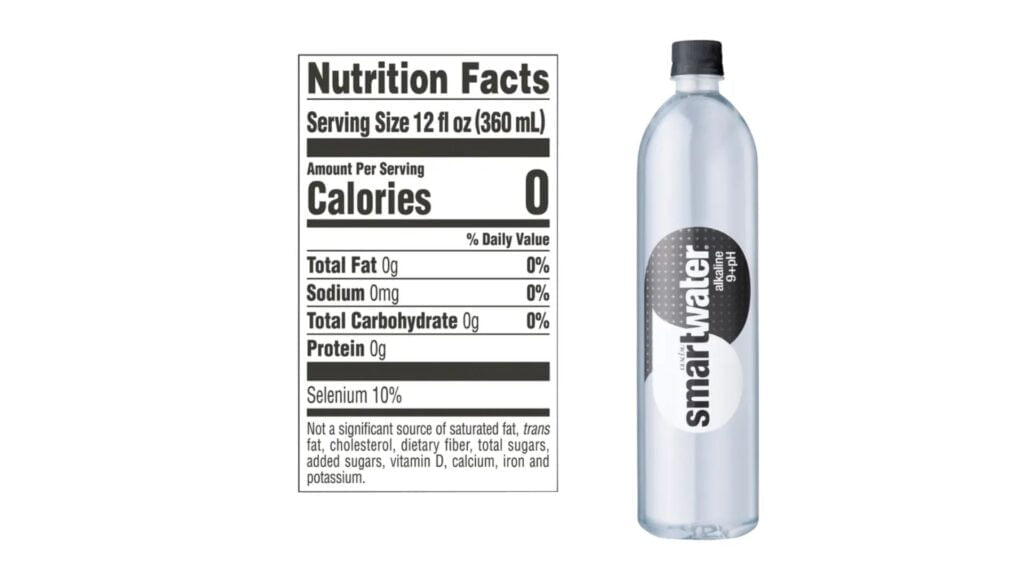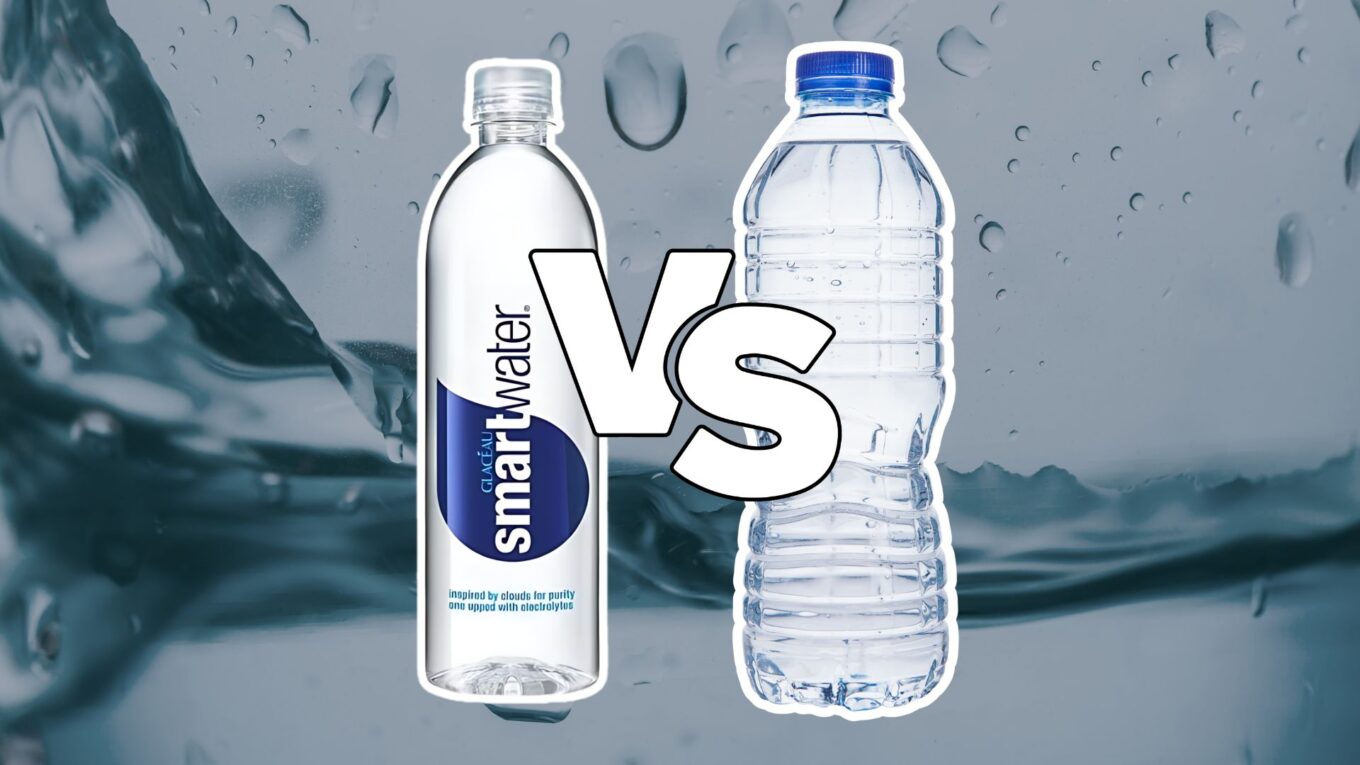When it comes to staying hydrated, we all know that water is essential. However, with so many options available, it can be tough to decide which type of water is the best choice.
Smart Water, with its unique features, has gained popularity, but is it better than regular bottled water?
In this blog post, we’ll take a close look at Smart Water and compare it to regular bottled water.
We’ll explore the differences in their production processes, added minerals, and potential benefits, giving you the information you need to make an informed decision.
By the end of this article, you’ll have a clear understanding of whether Smart Water is worth the hype or if regular bottled water is the way to go.
What is Smart Water?

Smart Water is a premium bottled water brand owned by The Coca-Cola Company.
It sets itself apart from other bottled waters through its vapor-distilled production process and the addition of electrolytes for taste enhancement.
Smart Water first hit the shelves in the United States in 1998, marking the beginning of its journey in the bottled water market.
The brand later expanded its reach, entering the UK market around 2014. From its inception, Smart Water has been marketed as a high-end product, promising consumers pure and clean water.
The Smart Water Production Process

1. Vapor Distillation
Mimicking Nature Smart Water undergoes a unique production process called vapor distillation, which aims to replicate the natural water cycle. Here’s how it works:
- Water is heated until it turns into vapor, leaving impurities such as minerals and dissolved solids.
- The purified vapor is then cooled and condensed into liquid form, resulting in clean, distilled water.
However, it’s worth noting that this process is energy-intensive, requiring approximately 78 calories of energy to produce just 1 liter of Smart Water.
2. Enhancing Taste with Electrolytes
After the vapor distillation process, Smart Water takes an extra step to enhance its taste profile. The purified water is infused with a blend of electrolytes, including:
- Calcium chloride
- Magnesium chloride
- Potassium bicarbonate
It’s important to understand that these electrolytes are added primarily for taste and not to replenish minerals lost during physical activity, as with sports drinks.
Smart Water vs. Regular Bottled Water
| Feature | Smart Water | Regular Bottled Water |
|---|---|---|
| Definition | Vapor-distilled water with added electrolytes | Natural or purified water without additional electrolytes |
| Production Process | Vapor distillation followed by the addition of electrolytes | Various processes: spring water, mineral water, purified water, etc. |
| Electrolytes | It contains calcium chloride, magnesium chloride, and potassium bicarbonate | Typically, it does not contain added electrolytes |
| Taste | Enhanced taste due to added electrolytes | Natural taste based on water source |
| Price | $1.00 – $1.50 for a 600ml bottle | $0.25 – $0.50 for a 500ml bottle (spring or purified water) |
| Packaging | 100% recyclable plastic bottles | Varies; many use recyclable plastic, and some use glass |
| Health Benefits | Marketed for improved taste and hydration; lacks fluoride | Contains natural minerals (varies by brand); may lack fluoride |
| Environmental Impact | Significant due to energy-intensive production and plastic waste | Significant due to plastic waste; less energy-intensive production |
| Market Positioning | Premium product targeted at health-conscious consumers | Wide range of products from budget to premium |
| Accessibility | Widely available but often found in premium sections | Widely available in supermarkets, convenience stores, and vending machines |
| Fluoride Content | It does not contain fluoride | Varies; often does not contain fluoride |
| Popularity | Popular among fitness enthusiasts and health-conscious individuals | Popular across a broad range of consumers |
| Unique Selling Points | Vapor distillation, added electrolytes, sleek packaging | Natural source, mineral content, affordability |
| Hydration | Effective for hydration; added electrolytes for taste | Effective for hydration; depends on water quality and source |
How is Smart Water Better?

1. The Advantage of Vapor Distillation
One of the main selling points of Smart Water is its purity. The vapor distillation process mimics the natural water cycle, freeing water from common contaminants.
The purification process used in Smart Water production offers several benefits:
- Removes common contaminants in tap water, such as chlorine, lead, and pesticides.
- Provides a clean, crisp taste due to the absence of impurities.
- It is ideal for people concerned about the quality and purity of their drinking water.
2. Electrolytes: Enhancing Taste and Hydration
Smart Water sets itself apart from regular bottled water by adding electrolytes to its purified water. While these electrolytes are primarily added for taste enhancement, they may also contribute to better hydration.
Smart Water contains three main electrolytes:
- Calcium Chloride: Adjusts the pH and alkalinity of the water, improving its taste. Calcium is also essential for strong bones and teeth.
- Magnesium Chloride: Supports muscle and nerve function, as well as cellular health. Magnesium contributes to the unique taste profile of Smart Water.
- Potassium Bicarbonate: Helps maintain fluid balance in the body and supports muscle function. Potassium also enhances the water’s taste.
It’s important to note that while these electrolytes are beneficial, the quantities present in Smart Water are relatively small and do not significantly contribute to meeting daily electrolyte needs.
Unlike sports drinks, designed to replenish electrolytes lost through intense physical activity, Smart Water’s electrolytes are more focused on taste enhancement.
3. Improved Hydration
The added electrolytes in Smart Water may make it more palatable for some consumers, encouraging them to drink more water throughout the day.
Staying well-hydrated is crucial for maintaining essential bodily functions, such as:
- Transporting nutrients and oxygen to cells
- Regulating body temperature
- Removing waste and toxins
- Supporting digestion and metabolism
While Smart Water can undoubtedly contribute to meeting daily hydration needs, it’s important to remember that it is not significantly superior to other hydration sources like regular tap water or other bottled water.
4. Packaging: Recyclability and Brand Appeal
Smart Water’s packaging is another factor that sets it apart from some other bottled water brands. The company has made efforts to make its bottles more environmentally friendly and appealing to consumers.
- 100% Recyclable Bottles: Smart Water bottles are made from 100% recyclable plastic, which is a step in the right direction for environmental sustainability. By using recyclable materials, the company aims to reduce its ecological footprint and contribute to a more sustainable future.
- Sleek, Minimalist Design: The design of Smart Water bottles is sleek and minimalist, which appeals to consumers who are looking for a premium, high-end product. The clear bottle showcases the purity of the water, while the simple label design conveys a sense of sophistication and quality.
- Brand Reputation and Trust: As a product of The Coca-Cola Company, Smart Water benefits from the extensive marketing and brand recognition associated with its parent company. Consumers who trust and appreciate Coca-Cola’s products may be more inclined to choose Smart Water over other bottled water brands.
5. Environmental Initiatives
In addition to using recyclable bottles, Smart Water has also made efforts to reduce its environmental impact in other ways. For example, the company has partnered with organizations to support water conservation and sustainability projects.
While Smart Water’s packaging and branding offer some benefits, it’s essential to consider the broader environmental impact of bottled water consumption.
Potential Drawbacks of Smart Water
1. Cost: The Price of Premium Hydration
One of Smart Water’s most significant drawbacks is its higher price point compared to other bottled water brands and tap water.
Smart Water is positioned as a premium product, which justifies its higher cost in the market. However, the price difference may not be worth the perceived benefits for many consumers.
If you regularly consume Smart Water, the cost can add up quickly over time. For example, if you drink two bottles of Smart Water per day at an average price of $1.50 per bottle, you would spend over $1,000 per year on bottled water alone.
In contrast, tap water is much more affordable and can be just as hydrating.
2. Environmental Impact: The Ecological Footprint of Bottled Water
Despite Smart Water’s efforts to use recyclable bottles, the production and disposal of plastic bottles still contribute to environmental pollution.
Many plastic bottles end up in landfills or oceans, where they take hundreds of years to decompose and harm marine life.
The vapor distillation process to purify Smart Water requires significant energy, increasing the product’s carbon footprint.
The transportation and distribution of bottled water also contribute to greenhouse gas emissions.
For consumers concerned about the environmental impact of their drinking water choices, there are more sustainable alternatives to bottled water. These include:
- Using a reusable water bottle and filling it with tap water
- Installing a water filter on your tap to improve the taste and quality of your water
- Supporting initiatives that will enhance access to clean drinking water in communities that need it
3. Health Concerns: Fluoride and BPA
While Smart Water is generally safe to drink, there are some potential health concerns.
Unlike many municipal tap water sources, Smart Water does not contain fluoride. Fluoride is a mineral that helps prevent tooth decay and cavities and is often added to public water supplies.
If you rely solely on Smart Water for your daily hydration needs, you may miss out on fluoride’s dental health benefits. This is especially important for children whose teeth are still developing.
Some plastic bottles, including those used for Smart Water, may contain bisphenol A (BPA), a chemical that can leach into the water and potentially cause health problems.
While many companies have phased out the use of BPA in their bottles, some consumers may still be concerned about the potential risks.
To minimize potential BPA exposure, look for bottles labeled as BPA-free or choose glass bottles instead of plastic.
Water Filtration Systems: A Cost-Effective Alternative
| Aspect | Water Filtration Systems | Regular Bottled Water | Smart Water |
|---|---|---|---|
| Initial Cost | Higher initial investment (e.g., $100-$500 for the system) | Low initial cost (e.g., $0.25 – $0.50 per bottle) | Low initial cost (e.g., $1.00 – $1.50 per bottle) |
| Ongoing Cost | Low ongoing cost (e.g., filter replacement every 6-12 months, $20-$100) | High ongoing cost (e.g., $91-$182 per year for daily use) | High ongoing cost (e.g., $365-$1,095 per year for daily use) |
| Cost per Gallon | Significantly lower (e.g., $0.02 – $0.10 per gallon) | Higher (e.g., $1.00 – $2.50 per gallon) | Highest (e.g., $6.00 – $10.00 per gallon) |
| Convenience | Continuous supply at home; no need to purchase frequently | Requires regular purchase and storage | Requires regular purchase and storage |
Water filtration systems provide continuous, clean, safe drinking water from your tap. This eliminates the need to constantly purchase and store bottled water, saving time and effort.
While the initial investment in a water filtration system may seem high, it can lead to significant long-term savings compared to regularly buying bottled water.
Over time, the cost per gallon of filtered water is much lower than that of bottled water.
There are several types of water filtration systems available, each designed to address different contaminants and improve the overall quality of your tap water:
- Activated Carbon Filters: These filters use activated carbon to remove chlorine, sediment, and other impurities that can affect the taste and odor of your water.
- Reverse Osmosis Systems: Reverse osmosis uses a semipermeable membrane to remove many contaminants, including dissolved solids, bacteria, and heavy metals.
- UV Filters: UV filtration uses ultraviolet light to kill microorganisms like bacteria and viruses, providing an additional layer of protection.
By removing contaminants like chlorine, lead, and sediment, water filtration systems can significantly improve the taste and overall quality of your tap water, making it a more appealing alternative to bottled water.
DIY Enhanced Water: A Step-by-Step Guide

Another alternative to buying pre-enhanced bottled water like Smart Water is to create your enhanced water at home using tap water and your choice of additives.
Step 1: Choose Your Base Water
Start with clean, filtered water as your base. You can use tap water filtered through a home filtration system or purchase purified water from the store.
Step 2: Select Your Additives
Decide which nutrients you want to add to your water based on your health goals and preferences. Some popular options include:
- Electrolyte powders: Look for low-calorie, no-sugar-added powders that contain essential minerals like sodium, potassium, and magnesium.
- Vitamin drops: Choose water-soluble vitamin drops, such as vitamin C or B-complex, to support overall health.
- Natural ingredients: Fresh lemon or lime juice, sliced cucumber, mint leaves, or a pinch of Himalayan salt can add flavor and nutrients.
Step 3: Measure and Mix
Follow the recommended serving size on the packaging of your chosen additives. For electrolyte powders and vitamin drops, this typically involves adding one serving to 8-16 ounces of water.
If using natural ingredients, add them to your water according to your taste preferences.
Step 4: Stir or Shake
Use a spoon or a shaker bottle to thoroughly mix the additives into your water until they are fully dissolved.
Step 5: Adjust to Taste
Sample your enhanced water and adjust the additives as needed to suit your taste preferences. You may want to add more or less of certain ingredients depending on the flavor and potency.
Step 6: Store and Enjoy
If you’ve made a larger batch of enhanced water, store it in the refrigerator to keep it fresh. Aim to consume your enhanced water within 24-48 hours for optimal taste and nutrient quality.
Summing It Up
While Smart Water offers a sleek and convenient option for hydration with added electrolytes, it’s essential to consider the potential drawbacks, such as bottled water’s higher cost and environmental impact.
By exploring alternative solutions like water filtration systems and DIY-enhanced water, you can enjoy clean, safe, and nutrient-enhanced drinking water without relying on single-use plastic bottles.
Ultimately, your best choice will depend on your needs, budget, and values.
So, take a moment to reflect on your hydration goals and consider making a change that benefits your health and the environment.
Whether you opt for a home filtration system or create your enhanced water, you’ll step towards more sustainable and cost-effective hydration.
What will you choose?




